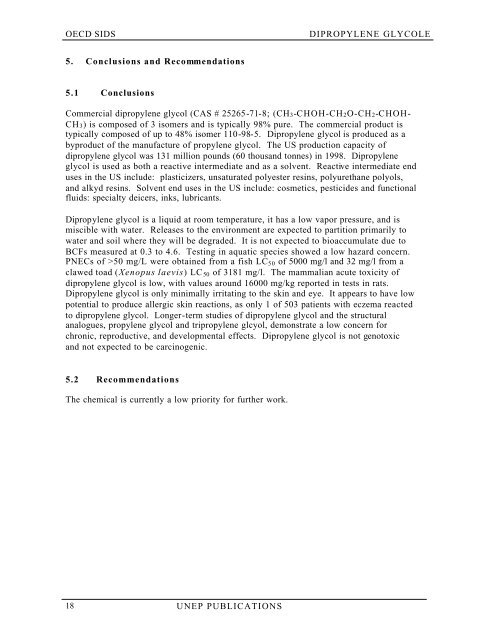Dipropylene glycol (SIDS)
Dipropylene glycol (SIDS)
Dipropylene glycol (SIDS)
You also want an ePaper? Increase the reach of your titles
YUMPU automatically turns print PDFs into web optimized ePapers that Google loves.
OECD <strong>SIDS</strong><br />
DIPROPYLENE GLYCOLE<br />
5. Conclusions and Recommendations<br />
5.1 Conclusions<br />
Commercial dipropylene <strong>glycol</strong> (CAS # 25265-71-8; (CH3-CHOH-CH2O-CH2-CHOH-<br />
CH3) is composed of 3 isomers and is typically 98% pure. The commercial product is<br />
typically composed of up to 48% isomer 110-98-5. <strong>Dipropylene</strong> <strong>glycol</strong> is produced as a<br />
byproduct of the manufacture of propylene <strong>glycol</strong>. The US production capacity of<br />
dipropylene <strong>glycol</strong> was 131 million pounds (60 thousand tonnes) in 1998. <strong>Dipropylene</strong><br />
<strong>glycol</strong> is used as both a reactive intermediate and as a solvent. Reactive intermediate end<br />
uses in the US include: plasticizers, unsaturated polyester resins, polyurethane polyols,<br />
and alkyd resins. Solvent end uses in the US include: cosmetics, pesticides and functional<br />
fluids: specialty deicers, inks, lubricants.<br />
<strong>Dipropylene</strong> <strong>glycol</strong> is a liquid at room temperature, it has a low vapor pressure, and is<br />
miscible with water. Releases to the environment are expected to partition primarily to<br />
water and soil where they will be degraded. It is not expected to bioaccumulate due to<br />
BCFs measured at 0.3 to 4.6. Testing in aquatic species showed a low hazard concern.<br />
PNECs of >50 mg/L were obtained from a fish LC 50 of 5000 mg/l and 32 mg/l from a<br />
clawed toad (Xenopus laevis) LC 50 of 3181 mg/l. The mammalian acute toxicity of<br />
dipropylene <strong>glycol</strong> is low, with values around 16000 mg/kg reported in tests in rats.<br />
<strong>Dipropylene</strong> <strong>glycol</strong> is only minimally irritating to the skin and eye. It appears to have low<br />
potential to produce allergic skin reactions, as only 1 of 503 patients with eczema reacted<br />
to dipropylene <strong>glycol</strong>. Longer-term studies of dipropylene <strong>glycol</strong> and the structural<br />
analogues, propylene <strong>glycol</strong> and tripropylene glcyol, demonstrate a low concern for<br />
chronic, reproductive, and developmental effects. <strong>Dipropylene</strong> <strong>glycol</strong> is not genotoxic<br />
and not expected to be carcinogenic.<br />
5.2 Recommendations<br />
The chemical is currently a low priority for further work.<br />
18<br />
UNEP PUBLICATIONS
















